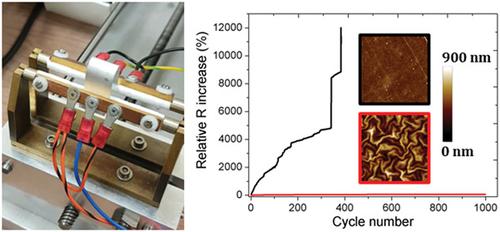当前位置:
X-MOL 学术
›
Plasma Processes Polym.
›
论文详情
Our official English website, www.x-mol.net, welcomes your feedback! (Note: you will need to create a separate account there.)
The wrinkling concept applied to plasma‐deposited polymer‐like thin films: A promising method for the fabrication of flexible electrodes
Plasma Processes and Polymers ( IF 3.5 ) Pub Date : 2020-07-23 , DOI: 10.1002/ppap.202000119 Damien Thiry 1 , Nathan Vinx 1 , Pascal Damman 2 , Francisco J. Aparicio 3 , Pierre‐Yves Tessier 4 , David Moerman 5 , Philippe Leclère 5 , Thomas Godfroid 6 , Sylvain Desprez 6 , Rony Snyders 1, 6
Plasma Processes and Polymers ( IF 3.5 ) Pub Date : 2020-07-23 , DOI: 10.1002/ppap.202000119 Damien Thiry 1 , Nathan Vinx 1 , Pascal Damman 2 , Francisco J. Aparicio 3 , Pierre‐Yves Tessier 4 , David Moerman 5 , Philippe Leclère 5 , Thomas Godfroid 6 , Sylvain Desprez 6 , Rony Snyders 1, 6
Affiliation

|
In this communication, we report on an innovative solvent‐free method that allows for the design of nano‐/micropatterns with tuneable dimensions. Our approach is based on the spontaneous wrinkling phenomenon taking place in a bilayer system formed by a mechanically responsive bottom plasma polymer layer and a top aluminum thin film. The dimensions of the wrinkles can be adjusted in a wide range (i.e., from nanometer to micrometer range) by modulating the cross‐linking density as well as the thickness of the plasma polymer layer. Finally, it is demonstrated that these wrinkled surfaces could efficiently be used as flexible electrodes. The whole set of our data unambiguously reveals the attractiveness of our method for the fabrication of the micro‐/nanopattern with dimensions on demand.
中文翻译:

皱纹概念适用于等离子体沉积的聚合物状薄膜:一种用于制造柔性电极的有前途的方法
在本交流中,我们报告了一种创新的无溶剂方法,该方法可设计尺寸可调的纳米/微图案。我们的方法基于在由机械响应性底部等离子体聚合物层和顶部铝薄膜形成的双层系统中发生的自发皱纹现象。皱纹的尺寸可以通过调节交联密度以及等离子聚合物层的厚度在很宽的范围内(即从纳米到微米范围)进行调节。最后,证明了这些起皱的表面可以有效地用作柔性电极。我们的全部数据清楚地显示了我们的按需尺寸制造微/纳米图案的方法的吸引力。
更新日期:2020-07-23
中文翻译:

皱纹概念适用于等离子体沉积的聚合物状薄膜:一种用于制造柔性电极的有前途的方法
在本交流中,我们报告了一种创新的无溶剂方法,该方法可设计尺寸可调的纳米/微图案。我们的方法基于在由机械响应性底部等离子体聚合物层和顶部铝薄膜形成的双层系统中发生的自发皱纹现象。皱纹的尺寸可以通过调节交联密度以及等离子聚合物层的厚度在很宽的范围内(即从纳米到微米范围)进行调节。最后,证明了这些起皱的表面可以有效地用作柔性电极。我们的全部数据清楚地显示了我们的按需尺寸制造微/纳米图案的方法的吸引力。



























 京公网安备 11010802027423号
京公网安备 11010802027423号